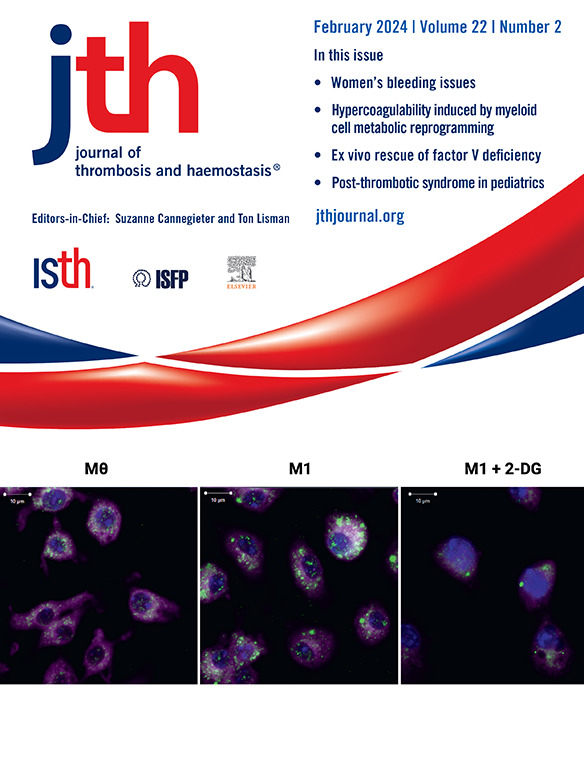接受肾移植的儿童抗凝预防的益处:系统回顾和荟萃分析。
IF 5
2区 医学
Q1 HEMATOLOGY
引用次数: 0
摘要
背景:移植物血栓形成是儿童肾移植后早期同种异体移植物丢失的一个可预防的原因,但初级血栓预防的作用尚不确定。目的:确定血栓预防在儿童(0-21岁)肾移植术后预防移植物血栓形成的有效性和安全性。方法:我们对MEDLINE、Embase和Cochrane图书馆从成立到2024年9月进行了系统的文献综述。通过荟萃分析评估的主要结局是移植物血栓形成,次要结局是大出血(根据国际血栓形成和止血协会的标准)。结果:25项观察性研究(21项回顾性研究,4项前瞻性研究)描述了2094例患者(1659例,435例对照)符合入选标准。血栓预防被普遍使用(即研究中所有肾受体),比例为64%(1,055/1,659)或仅在高危患者(受体体重)中使用。结论:初级血栓预防在预防儿童肾受体血管血栓形成导致的肾移植损失方面似乎有效。尽管出血风险因素尚不明确,但这种益处可能被出血风险所抵消。我们确定了知识差距,包括最佳血栓预防方案和治疗时间的不确定性。本文章由计算机程序翻译,如有差异,请以英文原文为准。
Benefits of anticoagulation prophylaxis in children undergoing kidney transplant: systematic review and meta-analysis
Background
Graft thrombosis is a preventable cause of early allograft loss after pediatric kidney transplant, but the role of primary thromboprophylaxis is uncertain.
Objectives
This study aimed to determine the effectiveness and safety of thromboprophylaxis in preventing graft thrombosis among children (0-21 years) undergoing kidney transplant.
Methods
We performed a systematic literature review of MEDLINE, Embase, and Cochrane Libraries from inception until September 2024. The primary outcome assessed by meta-analysis was graft thrombosis, and the secondary outcome was major bleeding (per International Society on Thrombosis and Haemostasis criteria).
Results
Twenty-five observational studies (21 retrospective and 4 prospective) describing 2094 patients (1659 cases and 435 controls) met eligibility criteria. Thromboprophylaxis was used universally (ie, all kidney recipients in the study) in 64% (1055/1659) or only in high-risk patients (eg, recipient weight <20 kg and age <5 years) in 36% (604/1659). Compared with no preventive measures for thrombosis, thromboprophylaxis was associated with reduced risk of graft thrombosis (odds ratio, 0.31; 95% CI, 0.18-0.53). Subgroup analyses of heparinoid-only, universal thromboprophylaxis, and high risk only protocols revealed similar findings. Thromboprophylaxis was not associated with increased risk of bleeding resulting in surgical exploration or graft loss. The overall risk of bias was moderate. Studies showed high clinical and methodologic heterogeneity in study populations and thromboprophylaxis protocols.
Conclusion
Primary thromboprophylaxis appears effective in preventing kidney graft loss from vascular thrombosis in pediatric recipients. This benefit may be offset by the risk of bleeding, although clarity on bleeding risk factors is lacking. We identified knowledge gaps, including uncertainty about optimal thromboprophylaxis regimens and treatment duration.
求助全文
通过发布文献求助,成功后即可免费获取论文全文。
去求助
来源期刊
CiteScore
24.30
自引率
3.80%
发文量
321
审稿时长
1 months
期刊介绍:
The Journal of Thrombosis and Haemostasis (JTH) serves as the official journal of the International Society on Thrombosis and Haemostasis. It is dedicated to advancing science related to thrombosis, bleeding disorders, and vascular biology through the dissemination and exchange of information and ideas within the global research community.
Types of Publications:
The journal publishes a variety of content, including:
Original research reports
State-of-the-art reviews
Brief reports
Case reports
Invited commentaries on publications in the Journal
Forum articles
Correspondence
Announcements
Scope of Contributions:
Editors invite contributions from both fundamental and clinical domains. These include:
Basic manuscripts on blood coagulation and fibrinolysis
Studies on proteins and reactions related to thrombosis and haemostasis
Research on blood platelets and their interactions with other biological systems, such as the vessel wall, blood cells, and invading organisms
Clinical manuscripts covering various topics including venous thrombosis, arterial disease, hemophilia, bleeding disorders, and platelet diseases
Clinical manuscripts may encompass etiology, diagnostics, prognosis, prevention, and treatment strategies.

 求助内容:
求助内容: 应助结果提醒方式:
应助结果提醒方式:


